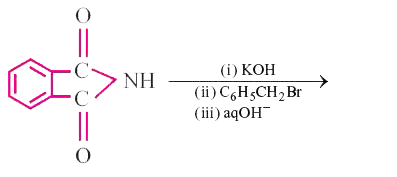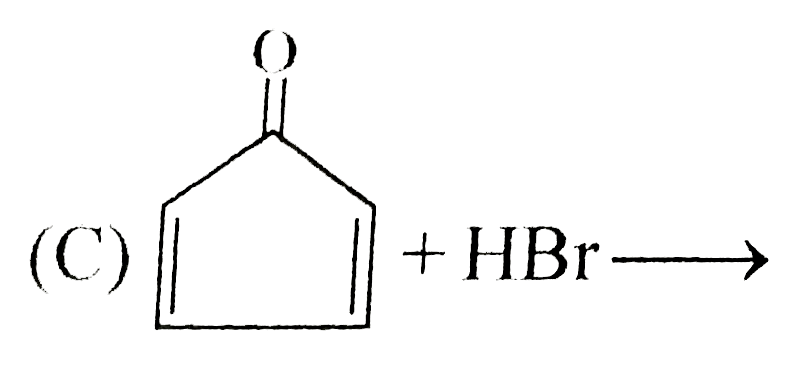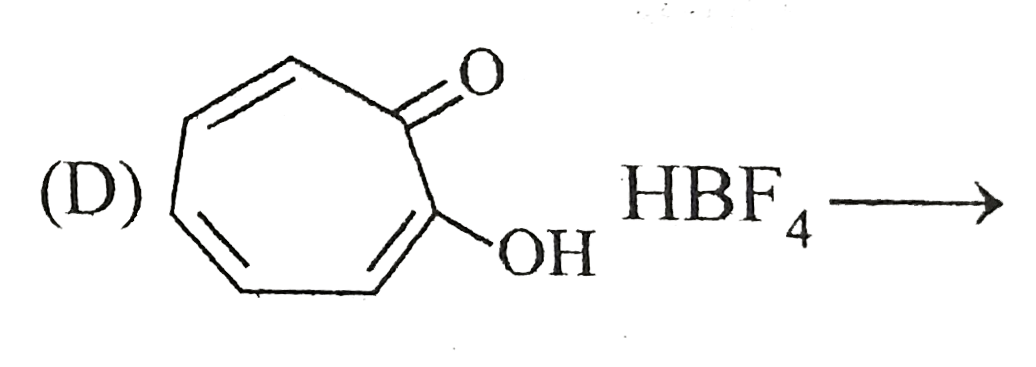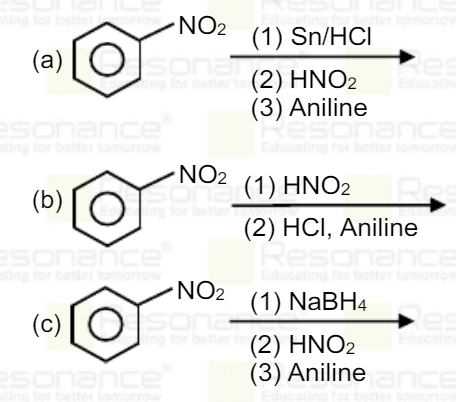Which of the following reactions form benzylamine:

C6H5CONH2NaOBr−−−→
C6H5CNH+/H2O−−−−−→

The correct Answer is:A, D
To determine which reactions form benzylamine, we will analyze the provided options step by step. Benzylamine is represented by the structure C6H5CH2NH2, which consists of a benzene ring (C6H5) attached to a CH2 group and an NH2 group.
1. Identify Benzylamine Structure:
- Benzylamine has the formula C6H5CH2NH2. It consists of a benzene ring (C6H5) attached to a methylene group (CH2) and an amino group (NH2).
2. Analyze the Reactions:
- We need to look at the reactions provided in the options and see if they can lead to the formation of benzylamine.
3. Reaction A:
- If the reaction involves reducing a carbonyl group (C=O) to a methylene group (CH2) while introducing an amino group (NH2), this could lead to the formation of benzylamine.
- For example, if we start with a compound like C6H5C(O)R and reduce it with a reducing agent like LiAlH4, it can yield C6H5CH2NH2.
4. Reaction B:
- If the reaction involves a nitrile group (C≡N) on the benzene ring undergoing acidic hydrolysis, it will yield benzoic acid (C6H5COOH) and ammonium ion (NH4+). This does not lead to benzylamine.
5. Reaction C:
- If thalamide reacts with a benzyl halide (C6H5CH2Br) in the presence of a base (like KOH), it can lead to the formation of benzylamine after hydrolysis.
- The reaction mechanism involves nucleophilic substitution where the thalamide anion attacks the benzyl halide, followed by hydrolysis to yield benzylamine.
6. Conclusion:
- Based on the analysis, the reactions that can form benzylamine are:
- Option A (Reduction of a carbonyl compound to yield CH2 and NH2)
- Option D (Thalamide reaction with benzyl halide followed by hydrolysis).
Final Answer:
- The reactions that form benzylamine are Option A and Option D.
- Benzylamine has the formula C6H5CH2NH2. It consists of a benzene ring (C6H5) attached to a methylene group (CH2) and an amino group (NH2).
- We need to look at the reactions provided in the options and see if they can lead to the formation of benzylamine.
- If the reaction involves reducing a carbonyl group (C=O) to a methylene group (CH2) while introducing an amino group (NH2), this could lead to the formation of benzylamine.
- For example, if we start with a compound like C6H5C(O)R and reduce it with a reducing agent like LiAlH4, it can yield C6H5CH2NH2.
- If the reaction involves a nitrile group (C≡N) on the benzene ring undergoing acidic hydrolysis, it will yield benzoic acid (C6H5COOH) and ammonium ion (NH4+). This does not lead to benzylamine.
- If thalamide reacts with a benzyl halide (C6H5CH2Br) in the presence of a base (like KOH), it can lead to the formation of benzylamine after hydrolysis.
- The reaction mechanism involves nucleophilic substitution where the thalamide anion attacks the benzyl halide, followed by hydrolysis to yield benzylamine.
- Based on the analysis, the reactions that can form benzylamine are:
- Option A (Reduction of a carbonyl compound to yield CH2 and NH2)
- Option D (Thalamide reaction with benzyl halide followed by hydrolysis).
- The reactions that form benzylamine are Option A and Option D.
Topper's Solved these Questions
- AMINESBOOK - CBSE COMPLEMENTARY MATERIALCHAPTER - AMINESEXERCISE - MCQ (Assertion and Reason)
2 Videos
- AMINESBOOK - CBSE COMPLEMENTARY MATERIALCHAPTER - AMINESEXERCISE - MCQ (Matching)
2 Videos
- ALDEHYDES,KETONES AND CARBOXYLIC ACIDSBOOK - CBSE COMPLEMENTARY MATERIALCHAPTER - ALDEHYDES,KETONES AND CARBOXYLIC ACIDSEXERCISE - LONG ANSWER TYPE QUESTIONS (5 MARKS)
21 Videos
- BIOMOLECULESBOOK - CBSE COMPLEMENTARY MATERIALCHAPTER - BIOMOLECULESEXERCISE - SHORT ANSWER-II TYPE QUESTION
13 Videos
Similar Questions
Knowledge Check
Which of the following reaction does not form an ether ?
AC6H6OH+RBraq.NaOH−−−−−→BCH3−CH3∣C∣CH3−CH=CH2+ROH+Hg(OOCCF3)2NaBF4−−−→C(CH3)3CCl+C2H5O−Na+→DCH3CH2OHH2SO4−−−→413KWhich of the following reaction will form stable ion.
A B
B C
C D
D
Which of the following reactions does not form salicylic acid ?
APermanganate oxidarion of o-cresolBReimer-Tiemann carboxylationCDuff reactionDKolbe-Schmidt reaction
In which of the following reaction t−butylbenzene is formed :
View SolutionIn which of the following reactions product formed is same ?

View SolutionIn which of the following reactions, MgO is not formed ?
View SolutionIn which of the following reactions, enantiomer is formed?
View SolutionIn which of the following reactions, enantiomer is formed?
View Solution

